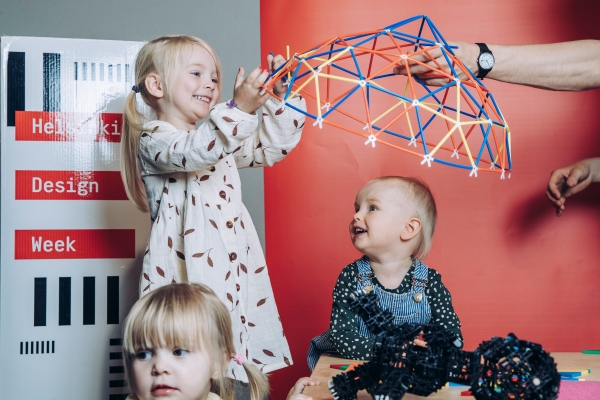The largest design festival in the Nordic countries, Helsinki Design Week continues the festival tradition of a dedicated programme for children and families for the seventh consecutive year. A sports-themed Children’s Design Weekend 12–13 September takes place at the renovated and modernized Helsinki Olympic Stadium. Children’s Design Week at Annantalo 7–13 September focuses on design workshops. Schools familiarize learners with design through PechaKucha presentations with a toolkit produced by Helsinki Design Week.
“Our programme for children offers such activities for the whole family that makes architecture and design familiar to citizens from childhood onwards. Thus we guide them to observe their built environment with a critical eye,” says Helsinki Design Week Programme Director Anni Korkman.
Helsinki Design Week produces the children’s programme, as well as all other programme content, in partnership with external event organizers. All children’s events are free of charge.
Children are guests of honour at Olympic Stadium
A part of Helsinki Design Week’s in-house production, HDW Children’s Design Weekend is held at the Helsinki Olympic Stadium on 12–13 September. The weekend features a route designed for children and built on the famous green of the Olympic Stadium. The route’s five playful sports sites combine sports and art, making design visible at the same time. Parents can join their children’s sports performances with instructions stored in QR codes. At the end of the route, children make their own trophies and pose with them on the podium. The trophy materials are available on the Helsinki Design Week website, so the programme can be duplicated at home.
As a part of Helsinki Design Week’s COVID-19 safety guidelines, registration is required to attend this free event.
Workshops at Annantalo

Annantalo, the City of Helsinki arts centre for children, young people and families, celebrates Children’s Design Week 7–13 September with a nature- and future-themed programme.
Workshops on the themes are held at Annantalo for groups from schools and day care centres. For example, 5th graders can create art with soil materials at the Annantalo yard in a workshop that combines mythology, architecture, art and biosciences.
A forest installation has been erected at the Annantalo yard: trunks of trees from forest thinning operations have been used to create a playful space resembling a forest. Three exhibitions on display inside the arts centre focus on ecology, the environment and the bond between a mother and her baby.
Most of the workshops are held outdoors. Safety is ensured indoors with sufficient distances maintained between occupants. Some of the workshops require registration.
Children’s Design Week at Annantalo
PechaKucha at schools
Learners at Helsinki comprehensive schools follow a Culture Path from one grade to the next. The path includes suggestions for cultural contents for each grade, and every learner should make at least one cultural visit in a year.
“Culture Path ensures that every learner has an opportunity to be familiarized with various cultural contents and cultural operators during their basic education,” says Pedagogical Specialist Panu Hatanpää of the City of Helsinki Education Division.
“Familiarizing learners with culture through Culture Path visits is part of new creative learning at Helsinki schools, and it is closely linked to familiarizing learners with design and design thinking,” Hatanpää emphasizes and points out that design is included in Culture Path contents.
There are no visits by school groups to Helsinki Design Week events this year. Visits are replaced by a toolkit produced by Helsinki Design Week for organizing PechaKucha presentations, one of the Design Week’s key programme items. PechaKucha is a form of storytelling, in which the presenter talks about a topic with 20 images, 20 seconds about each.
“PechaKucha is a good method for learners to practice making a presentation in front of an audience and to talk about topics of importance to them. For the audience, PechaKucha is a good method to practice listening,” Hatanpää says.
Helsinki Design Week’s PechaKucha toolkit is freely available to all. (Please note that the toolkit content is in Finnish only).
Design education in Helsinki

Design education is also in focus at Design Museum: A&DO Learning Centre for Architecture and Design organizes DesignLab: Mini Jam at the museum and online on 11 September. Talks by specialists and design-themed jamming shed light on future architecture and design learning and on the tone that public participation brings to urban design. The event is supported by the City of Helsinki.
“Helsinki has been a pioneer in architecture and design education for many years,” says Chief Design Officer Hanna Harris of the City of Helsinki. “We have several teachers and schools in Helsinki dedicated to the theme.”
For example, the Arabia Comprehensive School teaches design as part of creative problem solving that crosses subject boundaries, and the methods of design education are used in all subjects on grades 1–9. The Kruununhaka Comprehensive School for grades 7–9 offers a design track for local students.
“The City of Helsinki has joined forces with design organizations and projects to develop contents for architecture and design education for use by teachers, and we have participated in varied design collaborations. Our next step is to develop long-ranging activities within the City organization,” Harris asserts.
“I consider the following to be of very high importance: architecture and design education provides children and young people with means for creative problem solving and for the development of their identity. They learn to comprehend their neighbourhoods, to understand planning and various materials, and they obtain tools to participate in building our joint future.”
Read more
Helsinki Design Week
Children’s Design Week
Text: Johanna Lemola
Photos: Aleksi Poutanen/ Helsinki Design Week, Lauri Rotko / City of Helsinki, Aino Huovio / Helsinki Design Week

